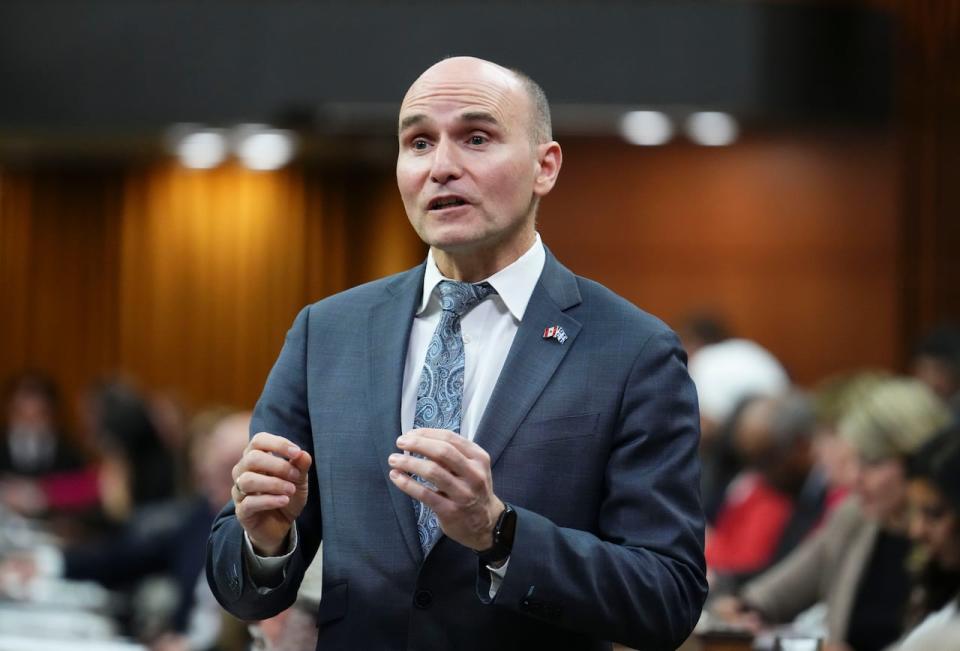Public servants uneasy as government 'spy' robot prowls federal offices
A device federal public servants call "the little robot" began appearing in Gatineau office buildings in March.
It travels through the workplace to collect data using about 20 sensors and a 360-degree camera, according to Yahya Saad, co-founder of GlobalDWS, which created the robot.
"Using AI on the robot, the camera takes the picture, analyzes and counts the number of people and then discards the image," he said.
Part of a platform known as VirBrix, the robot also gathers information on air quality, light levels, noise, humidity, temperature and even measures CO2, methane and radon gas.
We believe that one of the robot's tasks is to monitor who is there and who is not. - Bruce Roy, Government Services Union
The aim is to create a better work environment for humans — one that isn't too hot, humid or dim. Saad said that means more comfortable and productive employees.
The technology can also help reduce heating, cooling and hydro costs, he said.
"All these measures are done to save on energy and reduce the carbon footprint," Saad explained.
After the pilot program in March, VirBrix is set to return in July and October, and the government hasn't ruled out extending its use. It's paying $39,663 to lease the robot for two years.
Public servants feeling spied upon
Bruce Roy, national president of the Government Services Union, called the robot's presence in federal workplaces "intrusive" and "insulting."
"People feel observed all the time," he said in French. "It's a spy. The robot is a spy for management."
Roy, whose union represents more than 12,000 federal workers across several departments, said the robot is unnecessary because the employer already has ways of monitoring employee attendance and performance.
"We believe that one of the robot's tasks is to monitor who is there and who is not," he said.
"Folks say, why is there a robot here? Doesn't my employer trust that I'm here and doing my work properly?"

As the federal government prepares to require public servants to return to the office three days a week, Roy cast the robot as a means of controlling employees instead of creating a positive work environment.
Beyond that, the union is worried about the data the robot collects, how it will be used and where it will be stored.
"The robot can learn intimate details of our routines," he said. "For example, our washroom breaks."
According to Roy, the union is especially apprehensive given a previous run-in over sensors installed at employee workstations between January 2022 and March 2024.
PSPC spokesperson Jean-Pierre Potvin confirmed that 208 devices with movement and infrared sensors collected data on "the frequency and duration of workplace use."
The sensors cost the government $72,000.
Minister calls robot a tool to improve workplace
The federal government denies that the robot has anything to do with getting employees into the office three days a week come September.
Jean-Yves Duclos, the minister of public services and procurement, said the government is instead using the technology as it looks to cut its office space footprint in half over the coming years.
"These robots, as we call them, these sensors observe the utilization of office space and will be able to give us information over the next few years to better provide the kind of workplace employees need to do their job," Duclos said in French.
"These are totally anonymous methods that allow us to evaluate which spaces are the most used and which spaces are not used, so we can better arrange them."

Saad has a simple response to the surveillance fears.
"It isn't a spy," the GlobalDWS cofounder said, explaining it captures no information that might identify individual employees.
"It only measures environmental health and safety measures, and the number of people in a space," he said.
Though the robot typically deletes images soon after taking them, Saad acknowledges that there are rare cases where employers ask the company to retain them.
"In those cases we keep the images, but the whole body, not just the face, the whole body of the person is blurred," he said. These are exceptional cases where we need to keep images and then the images would be handed over to the client."
The data is then stored on a server on Canadian soil, according to GlobalDWS.
Employees treated 'like furniture,' researcher says
Given the distrust some public servants have for the robot, researcher Pierrot Péladeau said the government seems to be treating its employees "a little bit like furniture."
Péladeau, an adviser in the social assessment of information systems, has doubts about the quality of the data the robot will produce.
He said employees may decide to "toy with the robot" and behave differently in its presence simply to mess with the data it collects.
"They are making a big Swiss cheese," he said in French. "There are a lot of holes."
Besides, if the robot keeps the data anonymous and doesn't know who's in the office, it can only do so much to create a comfortable workplace. People have different preferences for temperature, lighting or humidity, Péladeau noted, so it will be hard to keep employees happy without knowing factors like their sex and age.
He suspects the data isn't truly anonymous. The system might spit out a report without identifying anyone, but that doesn't mean employees can't, in principle, be identified.
"If I know that there's a meeting at such a time ... or a person must be working at this workstation, it's clear that this information is about an identifiable person," he said.
"If the employer receives the information directly, there is a capacity to identify the person."


